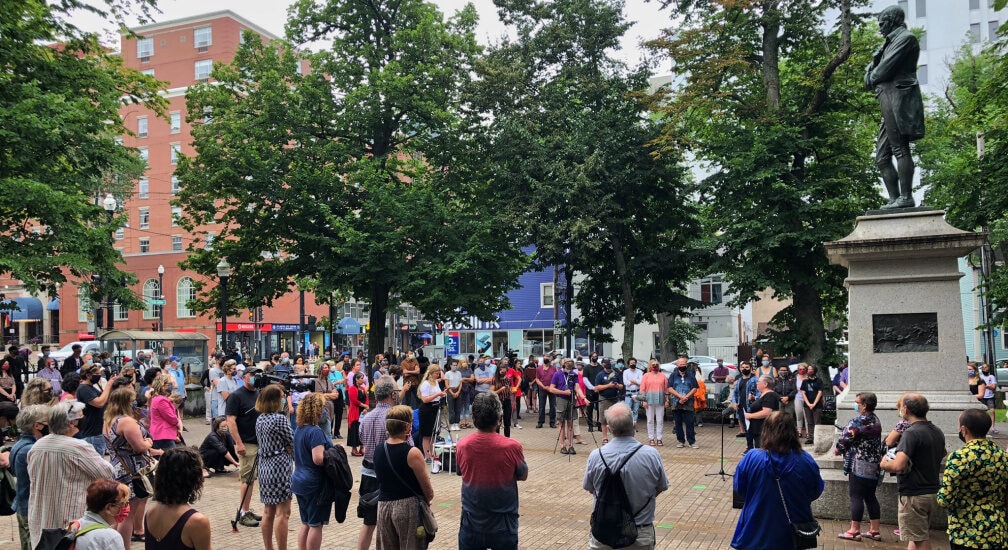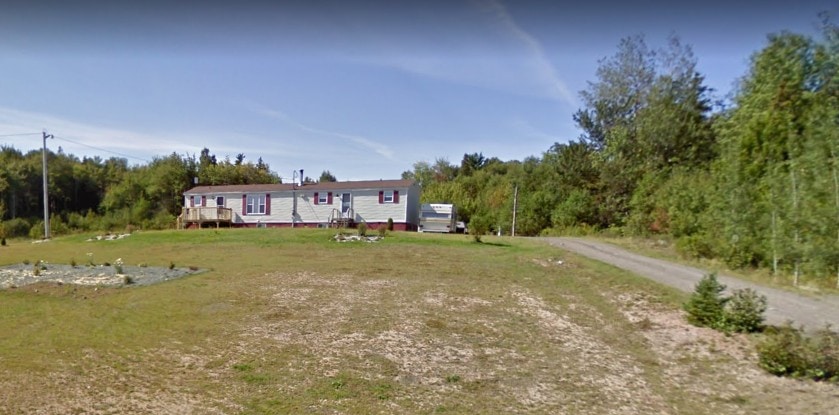
When the Halifax Chronicle Herald’s lead editorial, when the province’s best known print journalists including Jim Vibert, and Gail Lethbridge, The Halifax Examiner’s Tim Bousquet, Paul Palango, Stephen Kimber, Yvette D’Entremont, Jennifer Henderson, Joan Baxter and the Nova Scotia Advocate’s Jean Sarson, Linda MacDonald and I are shouting it from the rooftops– it’s time.
When the Nova Scotia Voice of Women for Peace, Women’s Wellness Within, the Immigrant Migrant Women’s Association of Halifax, NS Feminists Fighting Femicide, Persons Against Non-State Torture, the Antigonish Women’s Resource Centre and more than twenty women’s groups demand an open public inquiry with a feminist lens, it’s time.
When three dozen Canadian senators, when Lenore Zann – the local Liberal MP, when Nova Scotia’s two opposition parties, when a group of 34 Dalhousie law professors, when a petition with more than 10,000 signatures, when a 9,000-member strong Facebook group, when more than 60 workers at Nova Scotia transition houses and CUPE, their union, call for a public inquiry that examines the murders through the prisms of misogyny and feminist understanding, it’s time.
And when virtually all the relatives, neighbours and friends of the 22 deceased demand answers only a full public inquiry can discover, it’s time.
It’s time for Nova Scotia’s premier Stephen McNeil and Bill Blair, the federal minister of public safety, to admit they made a mistake.
Damage control
The mistake was to call for a non-public inquiry, or what they call an expert review panel, into the April murders of 22 Nova Scotians. The mistake was compounded by the government’s appointment of a panel of three. We know that the panel will likely find some fault with the RCMP, but from the government’s perspective, the right thing to do is to control the damage to the RCMP or any collateral damage stirred up by the inquiry.
The chair of the three-person panel is Michael MacDonald, the retired former chief justice of the Nova Scotia Supreme Court. Of course as a former judge, he has no direct political affiliation. One wonders how he can stomach an inquiry to be held in secret, which is set to ignore or at least downplay RCMP wrongdoing. The panel has no authority to compel public testimony under oath, and the RCMP can restrict or refuse to release information they present to the panel. RCMP officers who made deadly errors in police strategy during – and after — the Portapique massacre, will not be named or personally held to account. In short the parameters of the government’s inquiry fall far short of a full and transparent public inquiry.
The two other panellists are definitely compromised. Anne McLellan, who hails from Nova Scotia, is based in Alberta. A lawyer by training, she served as a cabinet minister in the Liberal governments of Jean Chretien, and Paul Martin. More recently, under Justin Trudeau, she was named an advisor to the Prime Minister’s Office (PMO). A lifelong Liberal, her record is one of obeisance to the Liberal party rule in Ottawa.
The third panellist is Leanne Fitch, Fredericton New Brunswick’s former police chief. She capped off a 34-year career in policing by serving her last seven years as chief before retiring in 2019. That same year she was appointed Vice Chair of the RCMP Management Advisory Board for the Federal Government. The board advises the RCMP on ‘cultural transformation’ and management practices to eliminate bullying, harassment and sexual violence inside the force.
Fitch’s police background and frontline work could mean she is less likely to investigate RCMP wrongdoings or demand open explanations. For example, in the last fifteen years there have been at least three inquiries into bullying, sex discrimination and sexual abuse of officers and other employees and volunteers with the RCMP. None were public. Though the final reports were publicly released, what happened during these inquiries was totally secret. There were no open hearings, no input from the public, no sworn testimony, and no repercussions or charges were laid. There have also been two monumental lawsuits against the RCMP for discrimination based on gender, and abuse of officers. There was no public accounting of what actually happened.
Item: In 2007, there was The “Brown Report” which made 49 recommendations to deal with the “culture of policing”, specifically to purge the RCMP of the fear and intimidation exacted by those in authority.
Item: In 2013, the Public Interest Investigation Report into Issues of Workplace Harassment within the RCMP looked at hundreds of cases of sexual harassment and bullying inside the police force and made 11 recommendations.
Item: The 2015 Fraser Report tracked the failure of the RCMP to effectively deal with workplace harassment. Canada’s former Auditor General Sheila Fraser looked specifically at four cases of women who faced serious harassment which ended their careers with the RCMP and made recommendations. The women officers were identified, but not their victimisers.
Item: In 2016, the RCMP had to compensate more than 3100 female former officers $100 million for harassment and sexual abuse. The RCMP assumed no liability, and there was no role for the public. Though the women complainants were publicly identified, the male harassers never were.
Item: In 2019, the RCMP once again paid out more than $100million to mainly female non-policing personnel, civilian employees and volunteers, for sexual harassment, physical assault, bullying based on gender or sexual orientation, sexual assault, and intimidation by their superiors.
Mark Furey will boost the RCMP no matter what
In Nova Scotia, we have an Attorney General and Minister of Justice who is a former RCMP District Commander. In fact, Mark Furey spent decades in the force and has yet to say a bad word about anything the RCMP has done—certainly he has not criticised the force over its response to the Portapique massacre. He has never done anything but boost the force, and its presence in the province.
Halifax is the only jurisdiction in the country in which a contract mandates city policing is shared between the Halifax Regional Police and the RCMP. But the RCMP in Halifax has made serious errors including tunnel vision – to put it nicely – in framing Glen Assoun for a murder he did not commit. In 2019, after 17 years in federal penitentiary Glen Assoun was exonerated in the killing of his former girlfriend, Brenda Way. Despite five other likely suspects, the RCMP closed in on Assoun and insisted he was the killer. What is more, the RCMP also destroyed all the files and computer evidence compiled by one of their own RCMP profilers who could prove Assoun innocent.
What is it with Nova Scotia which named two retired RCMP officers as Attorneys General and Ministers of Justice in ten years? In 2009, the NDP’s Dexter government appointed Ross Landry, also a former RCMP officer, to that role. These retired members of the RCMP are likely to sustain a law and order agenda, tend to protect fellow police, and have a very particular view of privilege and power in our society. But Mark Furey and our Premier (who has family members in the Halifax police and also some retired from the police) do not want to expose the RCMP to investigation or to possible criticism. For them, it’s personal.
With respect to the three person panel, Furey said, “I believe with the strength of this panel, their familiarity and awareness in this focus, we can get the same answers that we would through an inquiry. We will get those answers sooner than later and we will be able to act on those.” His comments are shorthand for spending less time and less money than would be spent on a full public inquiry.
However, we have seen that inquiries allow those immediately connected to the events, and the public to understand what really happened and what could be done to stop it from happening in future. We have seen the value of information gleaned through a public inquiry in the tragic murders and suicide committed by Lionel Desmond.
Parallels with the Desmond case
What happened in the 22 Nova Scotia killings case bear some similarities to the 2017 murders committed by Lionel Desmond, which also took place in rural Nova Scotia.
On January 3, 2017, Desmond, a 33-year-old African-Nova Scotian, who had served as a sniper in Canada’s infantry, shot his wife, their 10-year-old daughter, and his 52-year-old mother. Then he took his own life. The murders shook the province and the nation. Some suggested that Desmond’s actions resulted from Post-Traumatic Stress Disorder (PTSD), which stemmed from two tours of military service in Afghanistan in 2007.

More and more, the powerful and some in the public wanted to believe that it was PTSD that was the prime mover behind Desmond’s killings.
About a week after the murders, Dr Ardath Whynacht, a sociology professor at Mt Allison University, suggested, “This case is an anomaly if we look at it through the lens of PTSD. But it’s not an anomaly when we look at the trends in intimate partner violence … A woman is killed by intimate partners once every six days in Canada.”
She wasn’t the only one who doubted the PTSD narrative. Gail Lethbridge, a columnist for the Halifax Chronicle Herald, wrote four days after the killings: “Family and friends have said he [Desmond] was suffering from his wartime experiences… But let’s not forget that this was also a brutal act of domestic violence and take whatever facts we can from the Desmond tragedy to understand that, and to use it as an opportunity to address the massive problem of family violence.”
In June 2017, five months after the deaths, Gail Lethbridge was the first columnist to call for a public inquiry. That same month, Lionel Desmond’s two sisters demanded an inquiry. Their demands were echoed by others, yet the McNeil government and Nova Scotia’s chief medical examiner Matt Bowes ignored them for a year. Twelve months passed before McNeil called a public inquiry.
Some have suggested that the Premier balked at calling a public inquiry because of its cost. Perhaps the federal government finally pitched in some money for the inquiry since at least some of the blame for the killings had been ascribed to Desmond’s mental health difficulties which flowed from his military service.
In 2020, three years after the murders, the inquiry finally began. And it was extremely informative. From January until early February, there were almost daily media reports from the Desmond inquiry. They revealed a lot about the circumstances leading to Desmond shooting his family and himself.
It was testimony at the inquiry that revealed some resemblance between killers Desmond and GW, the mass murderer in Portapique. For example, Desmond and his wife Shanna had argued on January 1, 2017. The argument was intensifying, so she told him to leave their house that evening. He did leave. For her part, she had been considering divorce and had spoken about leaving him.
We don’t yet have a very clear picture of what happened in the lead up to the Portapique shootings. We do know that the police insisted at the outset that a domestic argument – that began when GW and his partner were at a neighbour’s house party had sparked GW’s rage and the shootings. Perhaps she had threatened to leave him. Some documents have shown that GW abused her often.
However the police’s position that a domestic argument sparked GW’s murder rampage was shortlived. Within the week, feminists and their supporters argued that the police were blaming the partner, who was in fact the victim of physical abuse. Also, the police had dared to say a disagreement or argument was a precipitating factor in the killings demonstrated the police had little time for the idea that GW sought the power of the police and used a police uniform and mock cruisers in an elaborate murder plan. After ten days the police withdrew their remark about attributing the murders to the domestic argument, but the damage had been done.
Here is a list of other similarities in the two cases:
| Desmond | GW |
| An argument, ostensibly about him driving his wife’s car into a ditch, led to anger after a party, led to possible violence in the home and his wife’s demand for him to leave the house that night. He returned 40 hours later to commit murders | An argument at a party continued at home; led to violent assault, injuries and tying up of partner. She escaped and hid overnight. He left the house and then set it on fire. |
| Stockpiled at least 3 rifles weapons and purchased and used a semi-automatic rifle on the day of the murders. All legal weapons | Stockpiled weapons; used a semi-automatic. Unknown how many weapons he owned; probably not licensed |
| Evidence the attack was planned | Evidence the attacks were planned |
| “A respectful guy” | “A good neighbour, very kind” |
| Police claim: An argument with his wife around a car in the ditch set off the chain of events | Police claim: Argument with partner set off the chain of events |
| Former n\sniper, infantryman | Fixated by military, and power (he owned 4 mock RCMP cars) |
| Changed into a military style camouflage outfit to commit murders | Changed into an RCMP outfit to commit some of the murders |
| Shot people he knew in their home | Shot some people in their homes |
| Shot with semi automatic—legal weapon | Shot with semi automatic—unlicensed firearms |
| In 2015, police had him hospitalised because he threatened suicide. | Police charged GW with assault of a teenager 18 years ago, he had had other run-ins with police |
| Killed 2 women and 1 girl. | Killed 12 women, 1 girl |
The RCMP has set the tone for the investigation, and the upcoming inquiry.
Historically, the RCMP refuses to see some criminal behaviour, especially attacks on women and children, through a feminist lens. To say they cannot see what is staring them in the mirror is an understatement. Since 2007, more than 3130 women, former RCMP officers and civilian employees, have filed two class action lawsuits against the RCMP for sexual harassment and discrimination. To date the RCMP has had to pay out more than $200 million.
The RCMP still speaks about “domestic violence” as a set of one-off incidents. It’s time that the public demand more from the RCMP when they deal with these horrible crimes predominantly against women and children. Can I remind readers that the majority of victims of the Portapique massacre were women, and there was one teenage girl.
Many circumstances lead to men shooting and killing women – but they must be investigated through a feminist lens. That is what would come into sharper focus if there were a full public inquiry.
Judy Haiven is on the steering committee of Equity Watch, a Halifax-based organization which fights bullying, racism and discrimination in the workplace. You can reach her at equitywatchns@gmail.com
With a special thanks to our generous donors who make publication of the Nova Scotia Advocate possible.
Subscribe to the Nova Scotia Advocate weekly digest and never miss an article again. It’s free!




Lenore Zann signed the press release in agreement with the McNeil government ‘s panel. She’s playing people while looking out for herself. I stopped reading after that.
James McLean, who –by the way –did not give his proper email so when I sent a private email to him it bounced back 3 times, I commented (ABOVE) that Zann was playing people. Not so: as far back as JUNE 11 Zann demanded that there be a full public inquiry that used a feminist analysis and a feminist approach . This was reported on Global TV here: https://globalnews.ca/news/7056852/n-s-shooting-inquiry-feminist-lens/
Now Mr McLean can read to the end of my article!